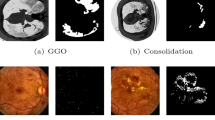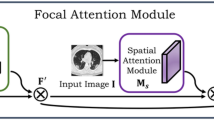Abstract
Deep learning-based image segmentation models rely strongly on capturing sufficient spatial context without requiring complex models that are hard to train with limited labeled data. For COVID-19 infection segmentation on CT images, training data are currently scarce. Attention models, in particular the most recent self-attention methods, have shown to help gather contextual information within deep networks and benefit semantic segmentation tasks. The recent attention-augmented convolution model aims to capture long range interactions by concatenating self-attention and convolution feature maps. This work proposes a novel attention-augmented convolution U-Net (AA-U-Net) that enables a more accurate spatial aggregation of contextual information by integrating attention-augmented convolution in the bottleneck of an encoder–decoder segmentation architecture. A deep segmentation network (U-Net) with this attention mechanism significantly improves the performance of semantic segmentation tasks on challenging COVID-19 lesion segmentation. The validation experiments show that the performance gain of the attention-augmented U-Net comes from their ability to capture dynamic and precise (wider) attention context. The AA-U-Net achieves Dice scores of 72.3% and 61.4% for ground-glass opacity and consolidation lesions for COVID-19 segmentation and improves the accuracy by 4.2% points against a baseline U-Net and 3.09% points compared to a baseline U-Net with matched parameters.



Similar content being viewed by others
References
Shi, F., Wang, J., Shi, J., Wu, Z., Wang, Q., Tang, Z., He, K., Shi, Y., Shen, D.: Review of artificial intelligence techniques in imaging data acquisition, segmentation and diagnosis for COVID-19. IEEE Rev. Biomed. Eng. 14, 4–15 (2020)
Dong, D., Tang, Z., Wang, S., et al.: The role of imaging in the detection and management of COVID-19: a review. IEEE Rev. Biomed. Eng. (2020). https://doi.org/10.1109/RBME.2020.2990959
Ulhaq, A., Khan, A., Gomes, D., Paul, M.: Computer vision For COVID-19 control: a survey. arXiv preprint (2020)
Li, K., Wu, X., Zhong, Y., Qin, W., Zhang, Z.: Diagnostic performance of CT and its key signs for COVID-19: a systematic review and meta-analysis. medRxiv (2020)
Naudé, W.: Artificial Intelligence against COVID-19: an early review. IZA Discussion Paper, No. 13110 (2020)
Nair, A., Rodrigues, J.C.L., et al.: A British Society of Thoracic Imaging statement: considerations in designing local imaging diagnostic algorithms for the COVID-19 pandemic. Clin. Radiol. 75(5), 329–334 (2020)
Burlacu, A., Crisan-Dabija, R., et al.: Curbing the AI-induced enthusiasm in diagnosing COVID-19 on chest X-Rays: the present and the near-future. medRxiv 2020.04.28.20082776
Nguyen, T.T.: Artificial intelligence in the battle against coronavirus (COVID-19): a survey and future research directions. arXiv (2020)
Li, L., Qin, L., Xu, Z., Yin, Y., Wang, X., Kong, B., Bai, J., Lu, Y., Fang, Z., Song, Q., Cao, K., Liu, D., Wang, G., Xu, Q., Fang, X., Zhang, S., Xia, J., Xia, J.: Using artificial intelligence to detect COVID-19 and community-acquired pneumonia based on pulmonary CT: evaluation of the diagnostic accuracy. Radiol. 296(2), E65–E71 (2020). https://doi.org/10.1148/radiol.2020200905
Shan, F., Gao, Y., et al.: Lung infection quantification of COVID-19 in CT images with deep learning. arXiv (2020)
Qi, X., et al.: Machine learning-based CT radiomics model for predicting hospital stay in patients with pneumonia associated with SARS-CoV-2 infection: a multicenter study, medRxiv (2020)
Chen, J., et al.: Deep learning-based model for detecting 2019 novel coronavirus pneumonia on high-resolution computed tomography: a prospective study. MedRxiv (2020)
Zheng, C., et al.: Deep learning-based detection for COVID-19 from chest CT using weak label. medRxiv (2020)
Jin, S., et al.: AI-assisted CT imaging analysis for COVID-19 screening: building and deploying a medical AI system in four weeks. medRxiv (2020)
Song, Y., et al.: Deep learning enables accurate diagnosis of novel coronavirus (COVID-19) with CT images. medRxiv (2020)
Gozes, O., et al.: Rapid ai development cycle for the coronavirus (covid-19) pandemic: initial results for automated detection and patient monitoring using deep learning CT image analysis. arXiv preprint arXiv:2003.05037 (2020)
Parmar, N., Ramachandran, P., Vaswani, A., Bello, I.: Stand-alone self-attention in vision models. In: Advances in Neural Information Processing Systems (2019)
Bello, I., Zoph, B., et al.: Attention augmented convolutional networks. In: Proceedings of the IEEE International Conference on Computer Vision (ICCV) (2019)
Chen, Y., Kalantidis, Y., et al.: A\(^2\)-Nets: double attention networks, In: Advances in Neural Information Processing Systems, vol. 31 (2018)
Wang, X., Girshick, R.B., Gupta, A., He, K.: Non-local neural networks. In: IEEE Conference on Computer Vision and Pattern Recognition (2018)
Vaswani, A., Shazeer, N., Parmar, N.U., Jakob, J., Llion, G., Aidan, Kaiser, N., Polosukhin, I.: Attention is all you need. In: Proceedings of the 31st International Conference on Neural Information Processing Systems (2017)
MedicalSegmentation.com, COVID-19 CT segmentation dataset. http://medicalsegmentation.com/covid19/
Schlemper, J., Oktay, O., Schaap, M., Heinrich, M., Kainz, B., Glocker, B., Rueckert, D.: Attention gated networks: learning to leverage salient regions in medical images. Med. Image Anal. 53, 197–207 (2019)
Oktay, O., Schlemper, J., et al.: Attention U-Net: learning where to look for the pancreas. CoRR abs arXiv:1804.03999 (2018)
Fan, D., et al.: Inf-Net: automatic COVID-19 lung infection segmentation from CT images. IEEE Trans. Med. Imaging 39(8), 2626–2637 (2020)
Ronneberger, O., Fischer, P., Brox, T.: U-net: convolutional networks for biomedical image segmentation. In: International Conference on Medical image computing MICCAI (2015)
Smith, L.N.: Cyclical learning rates for training neural networks. In: IEEE winter conference on applications of computer vision (WACV) (2017)
Rajamani, K.T., Siebert, H., Heinrich, M.P.: Dynamic deformable attention (DDANet) for semantic segmentation. medRxiv 2020.08.25.20181834 (2020)
Huang, Z., Wang, X., Huang, L., Huang, C., Wei, Y., Liu, W. In: 2019 IEEE/CVF International Conference on Computer Vision (ICCV), CCNet: Criss-Cross Attention for Semantic Segmentation (2019)
Author information
Authors and Affiliations
Corresponding author
Additional information
Publisher's Note
Springer Nature remains neutral with regard to jurisdictional claims in published maps and institutional affiliations.
Supplementary Information
Below is the link to the electronic supplementary material.
Rights and permissions
About this article
Cite this article
Rajamani, K.T., Rani, P., Siebert, H. et al. Attention-augmented U-Net (AA-U-Net) for semantic segmentation. SIViP 17, 981–989 (2023). https://doi.org/10.1007/s11760-022-02302-3
Received:
Revised:
Accepted:
Published:
Issue Date:
DOI: https://doi.org/10.1007/s11760-022-02302-3




